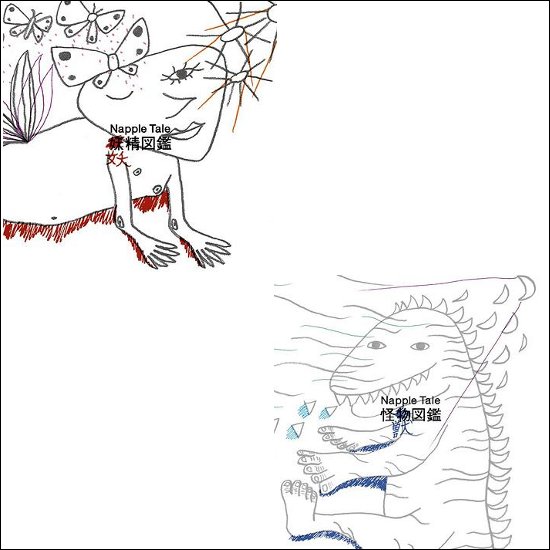 Yoko Kanno’s ability to diversify is insane. We love her for it. We previously gave her props for her work on Koei’s Uncharted Waters; and any anime fan will recognize her work from Cowboy Bebop, Gundam Wing, and other high-profile titles.
Yoko Kanno’s ability to diversify is insane. We love her for it. We previously gave her props for her work on Koei’s Uncharted Waters; and any anime fan will recognize her work from Cowboy Bebop, Gundam Wing, and other high-profile titles.
But how about a little-known, import-only Dreamcast title with fairies, monsters, and bright colors in a strange and beautiful fantasy world? Perhaps you haven’t heard of this one yet!
Well, the game is Napple Tale, and its soundtrack (released as two separate CDs) finally got a reprint in July 2009 after years of being relegated to “hard-to-find / out-of-print” status. You can pick up the two volumes, Illustrated Guide To The Fairies and Illustrated Guide To The Monsters, at Play-Asia (links take you to their store). Want more details as to the nature of the music? You’ll find it after the jump!
When I listen to Napple Tale‘s soundtrack, I am transported to a place that has never existed outside our imagination, even though its setting is a real place. I am, of course, thinking of the Schwarzwald (or “Black Forest”) in southwest Germany. This is the setting, and the place of origin, for dozens of fairy tales. The music I associate with this realm is, of course, European music from the 1800s and early 1900s. Romantic era and impressionist-style composers were often interested in putting their own musical spin to fairy tales and myths. Yoko Kanno continues this particular tradition with Napple Tale.
Let’s start with the game’s vocal theme, “Tail Song.” Performed by Kanno’s longtime partner-in-crime Maaya Sakamoto, this is simply a wonderful piece. And you know what it reminds me of? Stephen Sondheim’s timeless musical “Into The Woods.” The impressionist style is not unlike Masashi Hamauzu’s compositions, but there’s something *even lighter* about Tail Song. Something bouncier, fluffier, and more enchanting. One strange part that does stand out is when people start cheering and doing tongue rolls: that just sounds like something off of a Sigur Ros album.
Tail Song is found on the first volume, “Illustrated Guide to the Fairies.” Other tracks of note on the first of the two discs are as follows…
“Jumping Cracker,” track 5, sounds like crazy circus music, and it has live instrumentation all over the place. Xylophone, strings, wind, brass, cymbals and bass drums: it’s all here. This is an incredible recording.
“The Snow Princess,” track 7, is a Latin orchestral fantasy come true. Not sure how a Snow Princess has music that one would associate with warmer temperatures, but I like it nonetheless. Castanets, Spanish Guitar, and (again) a small orchestral ensemble to fill out the details. This is just beautiful music right here. Note also “Dual Tango” (track 16) for more Tango action.
“Balsam,” track 9, combines a tango-style melody with honky-tonk piano. There are many Yoko Kanno pieces that inspire me to take up ballroom dancing (many of which come from the Uncharted Waters II Special Edition disc); throw this one on the pile. I’ll be holding a rose by my teeth and dancing; meanwhile, someone will be filming me in black and white.
“Rain Waltz,” track 13, is one of the longest pieces on the disc, clocking in at nearly 5 minutes. And again, talk about wanting to take up ballroom dancing! This is a beautiful waltz piece. The most surprising thing about it is its ability to throw in unexpected instruments. Starting at about 2 minutes, you can hear a saxophone coming out through the rest of the orchestra. Then the orchestra backs off, and it’s just piano and sax. It still sounds elegant; the sax’s timbre is very close to an oboe in this situation.
There are a number of soft, simple tracks to be found. That’s what much of the album is. “Little Black Book,” track 21, is probably my favorite among them. A fast 3/4 tempo with some beautiful synthesized instruments, a wonderful chord progression: all the right ingredients to lull you to sleep, or into some sort of trance.
We also hear from Maaya Sakamoto at the end of the disc, in the track “Green Wings.” This is a slower ballad, but it builds over time and will surprise new listeners as it becomes stronger and stronger. And it’s all done outside the usual realm of J-pop cheese. The best of production values combined with some of the best talent in Japan (Yoko Kanno composing, Maaya Sakamoto singing) — you just can’t go wrong.
As usual, what we can glean just from the first of the two discs for Napple Tale is that Yoko Kanno pulls off a miraculous feat once again: she manages to use lots of different musical styles and yet it all sounds cohesive. Consider Cowboy Bebop or Uncharted Waters. Both have tons of styles and instruments packed in them. But when you say “Cowboy” and “Bebop,” you know that you’re getting a strange blend of jazz and country. With Uncharted Waters, the cohesion comes from being an “ethnic/world” soundtrack, with the consistent tie being the incredible instrumentalists. In the case of Napple Tale, it’s eccentric groups of chamber orchestra music performing music that fits a fantasy fairy-tale world.
But let’s move forward to the second volume, “Illustrated Guide to the Monsters.” Some exceptional tracks are…
“Bell Jar,” track 6, an Eastern European gypsy dance piece with some strange percussive effects processed into the final mix. The violins are awesome.
“Slow Water,” track 8, uses a complex time signature (I think it’s 11, groupings of 5 and 6, but I’m not sure) with a melodic pattern in the piano and melody from woodwinds. There are a number of tracks that can put you into a trance. I am always mesmerized when I hear this song.
“Crystal Palace,” track 11, fits the soundscape that I would call “Disney Fantasy music.” Very neo-romantic, bits of Tschaikovsky-esque grandeur. Great stuff.
“The Man in the Hole,” track 15, has the orchestral ensemble accompanying a male opera vocal. Presumably, the man singing is the “Man in the Hole” himself in the context of the game. This is a fun, and somewhat silly, performance piece. And at 2 minutes, it doesn’t overstay its welcome.
“Dreams in a Pie,” track 17, is my favorite song across both discs. Sakamoto sings in English, and I love the lyrics to this strange and beautiful 3/4 song. The opening is just Sakamoto and a piano. After the first verse, in the pre-chorus, a cello joins in. A full string/woodwind ensemble comes in for the chorus, and the song continues to build from there. It’s over 4 minutes long, and I just love this song. It’s actually the first song I ever heard from Napple Tale, when Lucy (aka “Chudah” of Chudah’s Corner) first introduced this music to me nearly a decade ago. And yes, it’s still my favorite. I’d love to be the pianist in a live performance of this song.
A nice companion piece to Dreams in a Pie is “Rabbit Bed,” track 18. Strings, piano, orchestral bells, and non-lyrical vocals from Sakamoto. Eerie lullabies are the best kind, are they not? This track rivals the pinnacle examples of this specific type of song. Cheers to Kanno and Sakamoto for this lovely piece.
I hope these text-based descriptions of the music get you excited to hear it. I can’t do the music justice, and I’m not interested in going track-by-track through both albums. I promise you, though, there are no “stinkers” across the two albums. Every track is well-composed and produced. You will find many things to love on both discs.
Agree? Disagree? Please leave your feedback in the comments section. Opinions from Yoko Kanno experts (who know a broad range of her music) are especially appreciated! We writers like learning from you as well after all!
Tags: Fairy Tales, Impressionism, Maaya Sakamoto, Napple Tale, reprints, Soundtrack of the Month, Yoko Kanno








































I have only heard Bell Jar and it’s every bit as good as you describe it.
I will have to check out the rest of this now, you did a good job of enticing me.
Ah, really nice review! The OST is pretty soothing and nice Also, I wonder if you will be doing a review of Tomba! (1 or 2) OST anytime, its all MIDI type but its really good… well, if not review, do check it out sometime
Also, I wonder if you will be doing a review of Tomba! (1 or 2) OST anytime, its all MIDI type but its really good… well, if not review, do check it out sometime 
Artists were Masaya Hiraoka and Ashif Hakik if I remember correctly (got it out of the credits roll video )
)
Agree. Greeeat OST. Can’t think of an anime/game composer with a more impressive oeuvre than Kanno.
I was pretty ignorant to her more whimsical side until mid last-year, having found her through Escaflowne (when *she* found Sakamoto Maaya).
Hearing Kanno perform the very playful ‘Dove Clock’ to a crowd nearing 20,000 in between the likes of Bebop crowd-fave ‘What Planet Is This!’ and the very popular Macross F Opening ‘Lion’ was inexplicable. But if there’s one thing we know about this woman, it’s that she simply has no discernible musical limits…and that whatever she attempts, she doesn’t so much ‘pull off’ as elevate. I can think of quite a few projects she’s worked on that would be pretty mediocre were it not for her music in the mix — Brain Power’d, Arjuna and Genesis of Aquarion are the easiest to conjure.
For newbies to Kanno (…if such still exist…), the three cd compilation/arrangement ‘Space Bio Charge’ is a really good introduction — and even if you have a few of her bigger OSTs, there are some gems on there…
[…] Original Sound Version » Blog Archive » Soundtrack of the Month 04 …… […]
Awesome artwork. Yet another SOTM from Patrick that I’ve never heard/played.
I actually owned the Napple Tale game(I might still have it somewhere), but this OST is just beautiful! Only thing is its still missing about 6-7 tracks such as Folly Fall, the 3″Rythm” songs, and the “Book of Monsters” and “Book of Fairies” which were song tracks not album titles. If you can purchase the game and own a functioning dreamcast you’ll be able to listen to the missing song titles in the Napple Tale rewards collection. Must not be missed. The music fits the game perfectly.
I’ve only listened to some tracks and I can say I can’t wait to get stuck into the rest of the OST!
On a side note, the singer of Rabbit is an Italian Girl called Ilaria Graziano, another beyond talented singer who has collaborated with Kanno several times (Ghost in the Shell SAC, Wolf’s Rain).